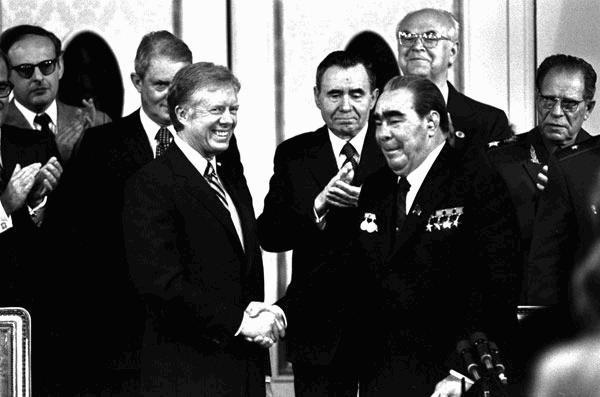Following the success of the first round of the Strategic Arms Limitation Talks (SALT) with the Interim Agreement between the United States and the Soviet Union, a second round of Strategic Arms Limitation Talks was carried out between 1972 and 1979. In the Salt I agreement, the U.S. and the Soviets agreed to freeze the combined number of intercontinental ballistic missiles (ICBMs) and submarine launched ballistic missiles (SLBMs) at the number they possessed in 1972 when the Interim Agreement was signed for a period of five years.
The SALT II goal was to limit the total number of all categories of delivery vehicles on either side to only two thousand two hundred and fifty. This would include missile warheads launched from either land based facilities or submarines as well as bombs dropped by aircraft. The proposed SALT II treaty also required that both sides not develop any new missiles. The intention to ultimate reduce nuclear arsenals was also part of the conversation. Major provisions of the Interim Agreement were to be carried forward into the new agreement which was to last until 1985.
The two sides disagreed on many particulars of a possible agreement. The old problem of U.S. presence in Europe and Soviet mid-range weapons aimed at Europe was a major sticking point in the discussions. A first draft of a possible agreement called the Vladivostok accord was made in 1975 where many of the points of dissention were ironed out. However, disagreement about U.S. cruise missiles and a new generation of Soviet bombers called Backfire were still a major problem.
At the start of the Carter Administration in 1977, a thorough review was made of the SALT II progress. Calls for additional reductions in nuclear weapons were added to the previous proposals and an offer to defer the cruise/Backfire problems to a third series of talks. The Soviets refused both of these new proposals by the U.S.
Eventually an agreement was reached that included several sections. The first part was a short term (3 year) agreement on cruise missiles, mobile ICBMs, and ICBM reductions. A framework was established for future negotiation. And, the Vladivostok accord was to be integrated into the final Treaty.
In mid-1979, U.S. President Carter and Soviet Premier Brezhnev signed the Treaty but the U.S. Congress refused to ratify the agreement. Neither leader was able to obtain the changes that Congress was demanding. Senator Joe Biden, now Vice President of the United States, managed to obtain the changes that were required.
Six months after the Treaty was signed but before it had been ratified by the U.S. Congress, the Soviet Union invaded Afghanistan. It was also made public that there was a Soviet combat brigade stationed in Cuba. These actions and revelations angered the U.S. government and people so much that the Treaty was never formally ratified. However, in 1982, U.S. President said that he would abide by the SALT II terms even without ratification. The Soviet Premier agreed that he too would abide by SALT II. Reagan later accused the Soviets of deviating from the SALT II provisions but pledged that the U.S. would continue to follow the SALT II framework.
SALT II signing photo from U.S. State Department:
